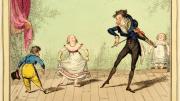The children in The Dancing Lesson, Pt. 2 are learning the minuet. The dancing master plays a pochette, a pocket violin. The girl at back stands in a narrow box called a tourne hanche–or, in English, a hip turner, turn-out boards, or the torture box–to train her feet to point at a wide angle, in genteel fashion, as do those of the dancers and the master himself. The hand-colored etching is by famed caricaturist George Cruikshank and depicts a moment from London’s social-dancing scene in 1824.
The etching is part of the vast collections in opera, ballet, operetta, musical theater, and popular song and dance from Elizabethan times to the present assembled by Mason professor of music emeritus John M. Ward and the late Ruth Neils Ward and given to the Harvard Theatre Collection, the Loeb Music Library, and the Houghton Library. “Professor Ward’s approach is comprehensive,” says Fredric W. Wilson, curator of the Theatre Collection. “If there are 13 editions of an opera, ideally he’d like to have all of them and maybe more than one copy of some. This is wonderful for researchers.” The Wards have demonstrated, Harvard University Library director Robert Darnton has written, “that collecting itself is a vital form of scholarship.”
At 92, John Ward is still avidly collecting—and giving. Moreover, he provides financial support for two library catalogers who try to keep up with the incoming flow not only of scores and scripts, but also of documentation about actual performances and the audiences who heard, saw, and responded to them.
Ward is interested both in music and in what people do with it. One thing they did in the post-Napoleonic-wars era in Britain was to disport themselves in the quadrille, a dance for four couples in square formation that allowed of many variations. Paine of Almack’s Quadrilles (London, c. 1815), at left, was a deck of gilt-edged cards providing reminders of the steps for many of the intricate variations on the theme. Each card is punctured at top, to be strung around the wrist. Andrea Cawelti, one of the Ward catalogers, explains: “At a ball, the dances were often not set ahead of time, and couples might not know until the last minute which dance was to be played. I can imagine the anxiety a participant might feel to excel, in a time when you were often judged by your dancing skill. A young person’s entire future might seem to hang on the ability to make a good impression.”









